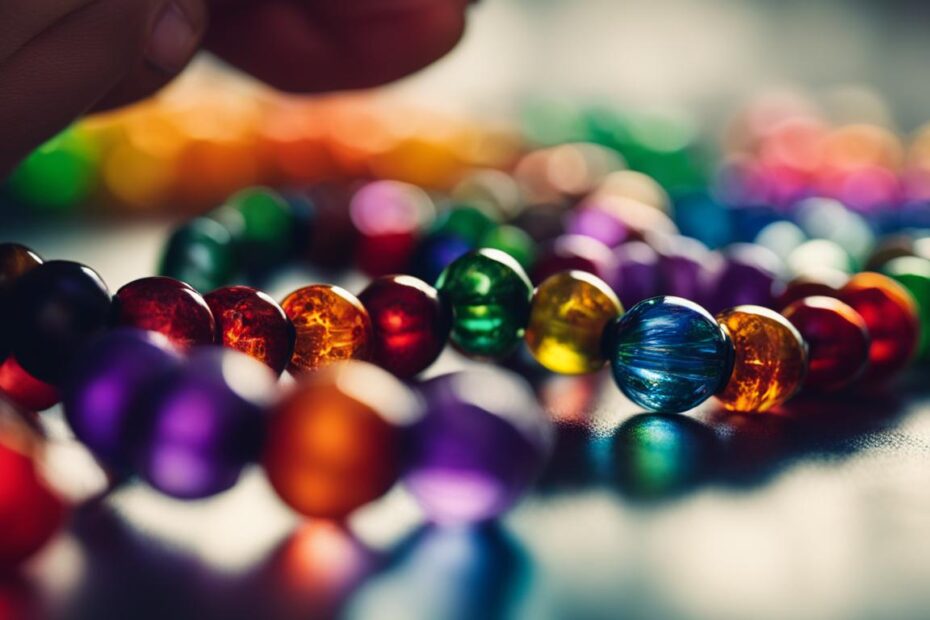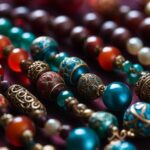Prayer beads, also known as Japa Mala or Mala beads, are powerful tools that can help individuals achieve serenity and spiritual enlightenment. These beads are used in various religious and spiritual practices, including meditation, prayer, and mindfulness. They symbolize the repetition of mantras or prayers and can aid in creating a deeper connection with the divine. There are different variations of prayer beads among different religious sects, and they are made using various materials like gemstones, wood, or seeds. Over time, prayer beads have evolved in their design and purpose, and there are also unique, lesser-known types of prayer tools available.
Key Takeaways:
- Prayer beads, also known as Japa Mala or Mala beads, are used in meditation, prayer, and mindfulness.
- They symbolize the repetition of mantras or prayers and help create a deeper connection with the divine.
- There are variations of prayer beads among different religious sects.
- Prayer beads are made using materials like gemstones, wood, or seeds.
- Over time, prayer beads have evolved in design and purpose, and there are unique, lesser-known prayer tools available.
Main Prayer Tools
In the realm of prayer and meditation, the main tool used by practitioners is the Japa Mala or Mala beads. These beads serve as a physical aid, helping individuals maintain focus and intention during their spiritual practices. Traditionally, Japa Malas are made up of 108 beads, although other numbers divisible by 9 can also be used. Each bead represents a mantra or prayer, and the repetition of these mantras or prayers helps cultivate mindfulness and spiritual connection.
The Japa Mala is held in the right hand, with the practitioner using their thumb to count each mantra or prayer by touching the beads. The index finger is extended and should not touch the beads. The large guru bead, located at the center of the Mala, is not counted and serves as a starting and ending point for the practice. The beads are moved in a clockwise direction, and the repetition continues until 108 repetitions are completed, or multiples of 108, depending on the practitioner’s preference.
While the Japa Mala is the primary prayer tool, there are other tools used in spiritual practices as well. These include meditation wands, pyramids, pendants, and yantras. Each of these tools serves a specific purpose, whether it be enhancing concentration, promoting inner peace, or inviting divine energy into one’s practice. The choice of prayer tool often depends on the individual’s spiritual beliefs and the specific intention behind their practice.
Table: Main Prayer Tools
| Prayer Tool | Purpose |
|---|---|
| Mala Beads | Aid in counting and repeating mantras or prayers during meditation and chanting. |
| Meditation Wands | Enhance concentration and focus during meditation practices. |
| Pyramids | Invite divine energy and promote spiritual alignment. |
| Pendants | Carry the energy and symbolism of a specific deity or spiritual concept. |
| Yantras | Represent sacred geometry and serve as visual aids for meditation and manifestation. |
How to Use Prayer Beads in Practice
Prayer beads, also known as Japa Mala or Mala beads, are powerful tools that can enhance your meditation, chanting, and spiritual practices. But how exactly do you use prayer beads in practice? Let’s explore the step-by-step process:
Step 1: Hold the Prayer Beads
Start by holding the prayer beads in your right hand. The beads should rest comfortably between your fingers and palm. You can drape the beads over your middle finger or hold them in your palm, whichever feels most comfortable to you.
Step 2: Begin the Repetition
Using your thumb, gently move from one bead to the next, starting with the bead next to the guru bead (the larger bead at the center). As you touch each bead, silently or audibly recite your chosen mantra or prayer. Each bead represents one repetition.
Step 3: Reach the Guru Bead
Continue moving from bead to bead until you reach the guru bead. When you reach this bead, you have completed one full round of repetitions. You can choose to end your practice here or reverse direction and start another round by turning the prayer beads around without crossing over the guru bead.
Step 4: Cultivate Mindfulness
While using the prayer beads, focus your attention on the sensations and vibrations of the beads as you move through each repetition. Allow yourself to become fully present in the moment and let go of distractions. This practice of mindfulness can deepen your connection with your chosen mantra or prayer.
By incorporating prayer beads into your spiritual practice, you can cultivate a sense of peace, focus, and spiritual connection. Whether you use them for meditation, chanting, or prayer, prayer beads serve as a tangible reminder of your intention and commitment. Start exploring the power of prayer beads and unlock the serenity within.
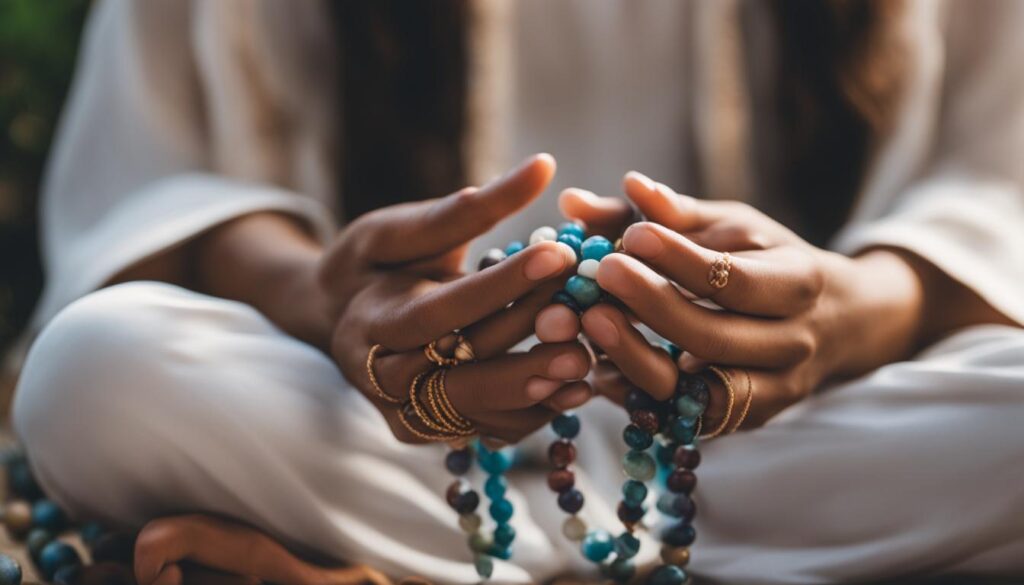
| Benefits of Using Prayer Beads | Materials Used for Prayer Beads |
|---|---|
|
|
Symbolism of Prayer Beads
Prayer beads hold deep symbolism in various spiritual practices, particularly in the context of Japa Mala. These beads are not mere accessories but serve as powerful tools for connecting with the divine and deepening one’s spiritual journey. They carry immense spiritual significance and symbolize the repetition of mantras or prayers, leading practitioners towards serenity and inner peace.
The Japa Mala beads, with their circular form and interconnectedness, represent the cyclical nature of life and the universe. Each bead on the mala signifies a mantra or prayer, emphasizing the importance of repetition as a means to focus the mind and cultivate mindfulness. By moving through the beads, practitioners create a rhythm that transcends the physical realm and fosters a deeper connection with the spiritual realm.
“The Japa Mala is a tangible reminder of our intentions and commitment to our spiritual practice. It helps to anchor our thoughts and intentions, allowing us to immerse ourselves fully in the present moment,” says spiritual teacher and author, Jane Thompson.
Furthermore, the number 108, often associated with Japa Malas, holds profound symbolism in various spiritual traditions. It is believed to represent the universe’s divine energy and the interconnectedness of all beings. Each repetition of a mantra or prayer brings practitioners closer to this cosmic energy, fostering a sense of unity and spiritual awakening.
| Symbolism of Prayer Beads | Japa Mala | Spiritual Significance |
|---|---|---|
| Circular form | Represents cyclical nature of life and universe | Connects practitioners with cosmic energy |
| 108 beads | Emphasizes repetition and focus | Cultivates mindfulness and spiritual awareness |
| Mantras and prayers | Serves as a tangible reminder of intentions | Deepens connection with the divine |
Variations Among Sects
Prayer beads have been an integral part of religious and spiritual practices across different sects. While the main purpose remains the same – to aid in prayer, meditation, and mindfulness – there are variations in the design, materials used, and specific rituals associated with prayer beads among different sects.
Buddhist Prayer Beads: In Buddhist traditions, prayer beads, often referred to as “malas,” are typically made from materials like wood, bone, or seeds. The most common form of Buddhist prayer beads consists of 108 beads, with a guru bead and tassel. These prayer beads are used while reciting specific mantras or sutras, helping practitioners focus their minds and deepen their spiritual connection.
Hindu Prayer Beads: In Hindu traditions, prayer beads are known as “rudraksha” beads or “tulsi” beads. Rudraksha beads are made from the seeds of the rudraksha tree, while tulsi beads are made from the sacred tulsi plant. These prayer beads are used during the repetition of mantras or prayers dedicated to specific deities, playing an essential role in Hindu religious rituals.
| Sect | Prayer Bead Materials | Design | Use |
|---|---|---|---|
| Buddhist | Wood, bone, or seeds | 108 beads with guru bead and tassel | Reciting mantras or sutras |
| Hindu | Rudraksha or tulsi seeds | Varies; often 108 beads | Repeating prayers to specific deities |
| Other Sects | Varies (gemstones, seeds, wood, etc.) | Varies; customized designs | Dependent on specific religious practices |
It’s important to note that there are also various other sects, religions, and spiritual practices that have their own unique variations of prayer beads, each with distinct materials, designs, and purposes. While the examples provided here showcase some of the commonly known practices, there is a rich diversity of prayer bead traditions worldwide.
Materials Used for Prayer Beads
Prayer beads, such as Japa Mala or Mala beads, are made from a variety of materials, each with its own unique qualities and significance. These materials are carefully chosen to enhance the spiritual experience and promote a deeper connection with the divine. Let’s explore some of the commonly used materials for prayer beads:
- Gemstones: Gemstone beads are popular for their energetic properties. Each gemstone is believed to possess specific healing or spiritual qualities. For example, amethyst is known for its calming effects, while rose quartz promotes love and compassion. Gemstone beads add beauty and vibrancy to prayer beads, making them visually appealing and spiritually uplifting.
- Wood: Wood beads, such as sandalwood or rosewood, are often used for their grounding properties. These natural materials have a comforting earthy scent that enhances the meditation experience. Wood beads symbolize a connection with nature and can bring a sense of calmness and stability to the practitioner.
- Seeds: Seeds, such as lotus seeds or rudraksha seeds, hold sacred symbolism and spiritual significance. Lotus seeds represent purity and spiritual growth, while rudraksha seeds are believed to have protective and healing properties. Seed beads are cherished for their natural beauty and connection to the earth.
Practitioners may choose the material for their prayer beads based on personal preferences, spiritual beliefs, or the specific energies they wish to enhance during their practice. The selection of materials adds depth and meaning to the prayer beads, making them not only a tool but also a reflection of one’s spiritual journey.
Comparative Table: Materials Used for Prayer Beads
| Material | Properties | Significance |
|——————-|————————————|———————————————————|
| Gemstones | Energetic qualities | Healing, spiritual enhancement, vibrancy |
| Wood | Grounding properties | Calmness, stability, connection to nature |
| Seeds | Sacred symbolism | Purity, growth, protection, healing |
As the table demonstrates, each material used for prayer beads brings its own unique properties and significance to the spiritual practice. Whether it be the energetic qualities of gemstones, the grounding nature of wood, or the sacred symbolism of seeds, the choice of material enriches the spiritual experience and aids in cultivating serenity and mindfulness during meditation or prayer.
Evolution of Prayer Beads over Time
Prayer beads, also known as Japa Malas or Mala Beads, have undergone significant changes throughout history, both in terms of design and materials used. Let’s explore the fascinating evolution of these spiritual tools.
Historical Changes
Prayer beads have a rich history dating back to ancient times. In the early days, natural materials like seeds, bones, or shells were used to create these sacred objects. As civilizations advanced, people began incorporating precious gemstones, such as amethyst, rose quartz, or lapis lazuli, into their prayer beads. These gemstones were believed to possess unique energetic properties and enhance the spiritual connection.
“The historical changes in prayer beads reflect the changing spiritual practices and beliefs of different cultures throughout time.”
Design and Purpose
Over time, the design of prayer beads has also evolved. Traditional Japa Malas typically consist of 108 beads, symbolizing the 108 earthly desires or human passions. Each bead represents a mantra or prayer, and the repetition of these chants helps to focus the mind and achieve a state of serenity. Today, prayer beads are available in various designs, including wrist malas, bracelets, or necklaces, offering individuals a wide range of options to incorporate spirituality into their daily lives.
Material Innovation
In addition to design changes, the choice of materials for prayer beads has expanded over the centuries. While natural materials like wood, seeds, and bone continue to be popular, modern prayer beads also feature materials such as glass, ceramic, or even precious metals like silver or gold. This diversity allows individuals to choose prayer beads that resonate with their personal preferences and spiritual beliefs.
| Material | Properties |
|---|---|
| Gemstones | Believed to possess specific healing or spiritual qualities |
| Wood | Grounding properties and natural scent |
| Seeds | Sacred symbolism and spiritual significance |
| Glass | Colorful and visually appealing |
| Precious Metals | Symbol of wealth and luxury |
The evolution of prayer beads showcases the deep-rooted connection between spirituality and human culture. These spiritual tools continue to bring solace, mindfulness, and serenity to millions of individuals worldwide, regardless of their religious or cultural backgrounds.
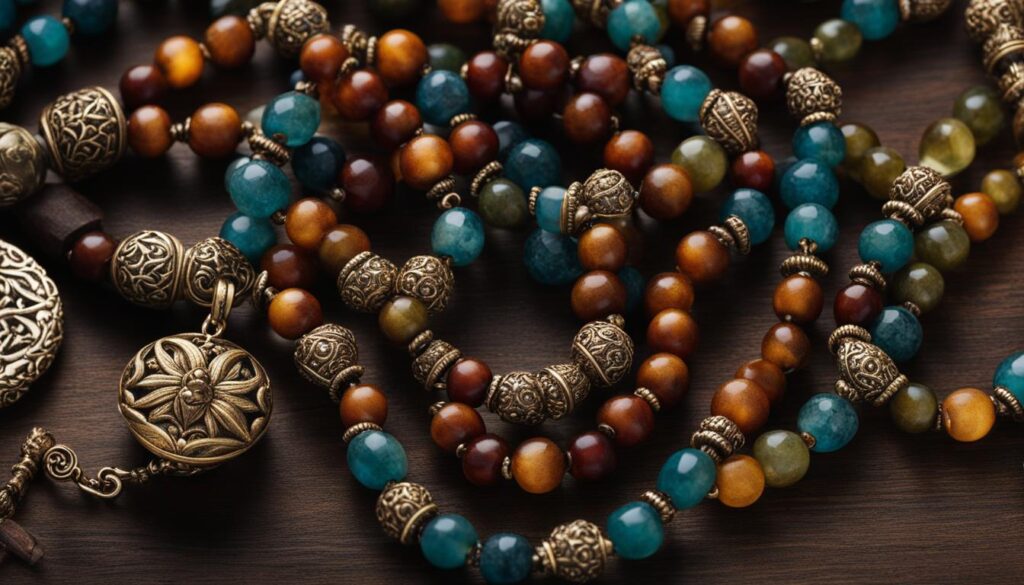
As we delve further into the world of prayer beads, we will explore lesser-known prayer tools that offer unique ways to enhance spiritual practices and foster a deeper connection with the divine.
Lesser-Known Prayer Tools
While the Japa Mala or Mala beads are the main prayer tools used in various spiritual practices, there are also lesser-known prayer tools available that can enhance one’s meditation, prayer, or mindfulness practices. These unique spiritual beads and mindful accessories offer individuals a variety of options to deepen their connection with their inner selves and promote spiritual growth.
One such lesser-known prayer tool is the gemstone bracelet. These bracelets are often made with specific gemstones that carry energetic properties believed to promote healing, balance, or protection. Each gemstone has its own unique qualities and vibrations that can amplify the intention and purpose of the wearer. Gemstone bracelets are a convenient and stylish way to incorporate the healing and spiritual benefits of gemstones into daily life.
Another lesser-known prayer tool is the wrist mala. Similar to the traditional Japa Mala, the wrist mala is a smaller version designed to be worn as a bracelet. Wrist malas typically have 27 or 54 beads, making them more portable and practical for daily use. They can be used for counting mantras or prayers during meditation or as a reminder of one’s spiritual practice throughout the day.
Healing pendants are also considered unique prayer tools that can be worn as necklaces. These pendants are often made with specific gemstones or symbols that hold spiritual significance and serve as a constant reminder of one’s intention and connection to the divine. The energy of the pendant is believed to radiate and support the wearer’s overall well-being and spiritual journey.
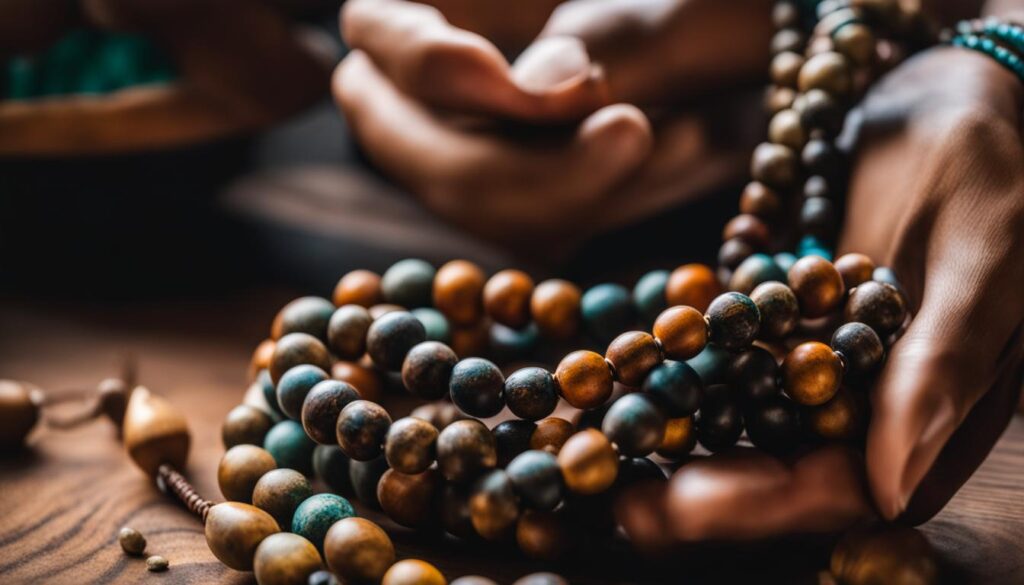
The availability of these lesser-known prayer tools provides individuals with the opportunity to explore and personalize their spiritual practices. Whether it’s wearing a gemstone bracelet, using a wrist mala, or adorning a healing pendant, these unique spiritual beads and mindful accessories can help individuals cultivate serenity, focus, and spiritual growth in their daily lives.
Conclusion
Prayer beads, or Japa Malas, are powerful tools used in various spiritual practices to promote serenity, focus, and spiritual growth. These beads have evolved over time, with different religions and cultures introducing their own variations.
Symbolizing the repetition of mantras or prayers, prayer beads serve as a physical reminder of intention and commitment in one’s spiritual journey. With a wide range of materials and designs available, individuals can find prayer beads that resonate with their spiritual beliefs and enhance their meditation, prayer, or mindfulness practices.
Whether made from gemstones, wood, or seeds, prayer beads hold deep significance in different religious sects. Each sect may have its own unique variations, incorporating specific symbols and rituals. The use of prayer beads helps foster a deeper connection with the divine and cultivate inner peace.
In conclusion, prayer beads are sacred tools that have stood the test of time. They continue to play a vital role in spiritual practices, offering individuals a tangible way to connect with their inner selves and the divine energy that surrounds us all.
FAQ
What are prayer beads?
Prayer beads, also known as Japa Mala or Mala beads, are powerful tools used in various religious and spiritual practices, including meditation, prayer, and mindfulness. They symbolize the repetition of mantras or prayers and aid in creating a deeper connection with the divine.
How do prayer beads work?
Prayer beads are used for counting and repeating mantras or prayers during meditation or chanting. They provide a physical and tactile element to the practice, helping to maintain focus and intention. The beads are held in the right hand, and the practitioner uses their thumb to count each mantra or prayer by touching the beads.
What is the significance of 108 beads?
The number 108 has spiritual significance in various religions and is associated with the universe and its divine energy. Each bead represents a mantra or prayer, and the repetition helps to focus the mind, cultivate peace, and deepen spiritual awareness.
What materials are prayer beads made from?
Prayer beads can be made from a variety of materials, including gemstones, wood, seeds, and other natural materials. Different materials are believed to have specific energetic or spiritual qualities, and the choice often depends on the practitioner’s personal preferences and beliefs.
Are there different types of prayer beads in different religions?
Yes, different religious sects have their own variations of prayer beads. In Buddhist traditions, prayer beads are often made from wood, bone, or seeds, and are used while reciting specific mantras or sutras. Hindu traditions have their own prayer beads known as “rudraksha” beads or “tulsi” beads, made from sacred plants. Other religions and spiritual practices may also have their unique variations of prayer beads.
Can you tell me more about the use of prayer beads?
Prayer beads are used to cultivate focus, mindfulness, and spiritual connection. The repetition of mantras or prayers, known as Japa, helps individuals deepen their spiritual practice. They are held in the right hand, with the thumb counting each mantra or prayer by touching the beads. The large guru bead at the center is used as a starting and ending point.
Can prayer beads be used for purposes other than meditation?
Yes, prayer beads can also be used for prayer, mindfulness, and as a physical reminder of one’s intention and commitment to their spiritual practice. They serve as a tool to connect with the divine and promote serenity and spiritual growth.
Are there other prayer tools besides prayer beads?
Yes, besides prayer beads, there are other prayer tools available such as meditation wands, pyramids, pendants, and yantras. Each of these tools serves a specific purpose in spiritual practices, such as promoting healing, balance, or protection.
How have prayer beads evolved over time?
Prayer beads have evolved in terms of design, materials used, and purpose. In ancient times, they were made from natural materials like seeds, bones, or shells. As civilizations progressed, the use of gemstones and other precious materials became more common. Different cultures and religions introduced their own variations of prayer beads, incorporating specific symbols and rituals.
How can prayer beads enhance spiritual practices?
Prayer beads provide a physical and tactile element to spiritual practices, helping to maintain focus and intention. They serve as a reminder of one’s commitment and can deepen the connection with the divine. The choice of prayer beads that resonate with personal beliefs can enhance meditation, prayer, or mindfulness practices.


